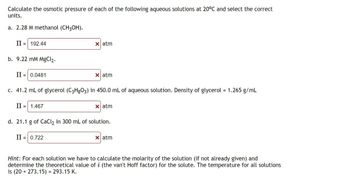
Chemistry
10th Edition
ISBN: 9781305957404
Author: Steven S. Zumdahl, Susan A. Zumdahl, Donald J. DeCoste
Publisher: Cengage Learning
expand_more
expand_more
format_list_bulleted
Concept explainers
Question

Transcribed Image Text:Calculate the osmotic pressure of each of the following aqueous solutions at 20°C and select the correct
units.
a. 2.28 M methanol (CH3OH).
II = 192.44
b. 9.22 mM MgCl2.
II = 0.0481
II = 1.467
x atm
c. 41.2 mL of glycerol (C3H8O3) in 450.0 mL of aqueous solution. Density of glycerol = 1.265 g/mL
x atm
II = 0.722
x atm
d. 21.1 g of CaCl₂ in 300 mL of solution.
x atm
Hint: For each solution we have to calculate the molarity of the solution (if not already given) and
determine the theoretical value of i (the van't Hoff factor) for the solute. The temperature for all solutions
is (20+ 273.15) = 293.15 K.
Expert Solution
This question has been solved!
Explore an expertly crafted, step-by-step solution for a thorough understanding of key concepts.
This is a popular solution
Trending nowThis is a popular solution!
Step by stepSolved in 5 steps

Knowledge Booster
Learn more about
Need a deep-dive on the concept behind this application? Look no further. Learn more about this topic, chemistry and related others by exploring similar questions and additional content below.Similar questions
- Calculate the molality of a solution formed by adding 3.159 g of methanol (CH3OH) to 100.00 mL of water. The density of water is 0.9982 g/mL. DO not include units. The lattice energy for KF is 821 kJ/mol. The enthalpy of hydration for K+ is -336 kJ/mol and the enthalpy of hydration for F- is -431 kJ/mol. What is the enthalpy in kJ when 14.91 g of KF forms an aqueous solution? (Hint: start by finding the enthalpy of solution)arrow_forwardYour pure water boils at 100.00 C. You add some sugar into it and now it boils at 101.20C. What is the molality? Kb= 0.512 Ckg/molarrow_forward5. Lysozyme is an enzyme that cleaves cell walls. A 0.100-L sample of a solution of lysozyme that contains 0.0750 g of the enzyme exhibits an osmotic pressure of 1.32 x 103 atm at 25 °C. What is the molar mass of lysozyme?arrow_forward
- At 25.0 °C, 100.0 mL of an aqueous solution containing 45.2 mg of a molecular solute has an osmotic pressure of 18.4 Torr. The molar mass of the solute is ___ g/mol.arrow_forwardWhat is the molality of a solution made by dissolving 25.9 grams of CaCl 2 in 625 grams of water? 0.747 m 10.5 m 0.00594 m 0.00686 m 0.373 marrow_forwardplease explainarrow_forward
- 1. Which of the following solutions will have the lowest freezing point for the same mass of solvent? 2.The osmotic pressure of a 0.10 M solution of sucrose, C12H22O11 will be ________ the osmotic pressure of a 0.10 M solution of fructose, C6H12O6. 3.A solution containing a nonvolatile solute will have a boiling point___________the boiling point of the pure solvent.arrow_forwardAn aqueous solution containing 9.15 g of a certain non-electrolyte has a volume of 590 mL. The solution's osmotic pressure at 25 °C was found to be 1.75 torr. Calculate the molar mass of the compound. 2.17×10-1 g/mol 2.17×102 g/mol 1.38×104 g/mol 1.65×105 g/mol 1.67×107 g/molarrow_forwardWhen 4.30 g4.30 g of a nonelectrolyte solute is dissolved in water to make 935 mL935 mL of solution at 24 °C,24 °C, the solution exerts an osmotic pressure of 885 torr.885 torr. 1.What is the molar concentration of the solution? 2.How many moles of solute are in the solution? 3.What is the molar mass of the solute?arrow_forward
- How many grams of CaCl2 are there in 197 grams of an aqueous solution that is 10.2 % by weight CaCl2. |g CaCl2arrow_forwardWhat is the molality of a 4.90 M NaNO3 solution. The density of the solution is 1.22 g/mL Molar mass of NaNO3 is 84.99 g/mol. 4.02 m O 6.10 m O 6.58 m O 3.95 m 5.82 m 4.15 marrow_forward
arrow_back_ios
arrow_forward_ios
Recommended textbooks for you
 ChemistryChemistryISBN:9781305957404Author:Steven S. Zumdahl, Susan A. Zumdahl, Donald J. DeCostePublisher:Cengage Learning
ChemistryChemistryISBN:9781305957404Author:Steven S. Zumdahl, Susan A. Zumdahl, Donald J. DeCostePublisher:Cengage Learning ChemistryChemistryISBN:9781259911156Author:Raymond Chang Dr., Jason Overby ProfessorPublisher:McGraw-Hill Education
ChemistryChemistryISBN:9781259911156Author:Raymond Chang Dr., Jason Overby ProfessorPublisher:McGraw-Hill Education Principles of Instrumental AnalysisChemistryISBN:9781305577213Author:Douglas A. Skoog, F. James Holler, Stanley R. CrouchPublisher:Cengage Learning
Principles of Instrumental AnalysisChemistryISBN:9781305577213Author:Douglas A. Skoog, F. James Holler, Stanley R. CrouchPublisher:Cengage Learning Organic ChemistryChemistryISBN:9780078021558Author:Janice Gorzynski Smith Dr.Publisher:McGraw-Hill Education
Organic ChemistryChemistryISBN:9780078021558Author:Janice Gorzynski Smith Dr.Publisher:McGraw-Hill Education Chemistry: Principles and ReactionsChemistryISBN:9781305079373Author:William L. Masterton, Cecile N. HurleyPublisher:Cengage Learning
Chemistry: Principles and ReactionsChemistryISBN:9781305079373Author:William L. Masterton, Cecile N. HurleyPublisher:Cengage Learning Elementary Principles of Chemical Processes, Bind...ChemistryISBN:9781118431221Author:Richard M. Felder, Ronald W. Rousseau, Lisa G. BullardPublisher:WILEY
Elementary Principles of Chemical Processes, Bind...ChemistryISBN:9781118431221Author:Richard M. Felder, Ronald W. Rousseau, Lisa G. BullardPublisher:WILEY

Chemistry
Chemistry
ISBN:9781305957404
Author:Steven S. Zumdahl, Susan A. Zumdahl, Donald J. DeCoste
Publisher:Cengage Learning

Chemistry
Chemistry
ISBN:9781259911156
Author:Raymond Chang Dr., Jason Overby Professor
Publisher:McGraw-Hill Education

Principles of Instrumental Analysis
Chemistry
ISBN:9781305577213
Author:Douglas A. Skoog, F. James Holler, Stanley R. Crouch
Publisher:Cengage Learning

Organic Chemistry
Chemistry
ISBN:9780078021558
Author:Janice Gorzynski Smith Dr.
Publisher:McGraw-Hill Education

Chemistry: Principles and Reactions
Chemistry
ISBN:9781305079373
Author:William L. Masterton, Cecile N. Hurley
Publisher:Cengage Learning

Elementary Principles of Chemical Processes, Bind...
Chemistry
ISBN:9781118431221
Author:Richard M. Felder, Ronald W. Rousseau, Lisa G. Bullard
Publisher:WILEY